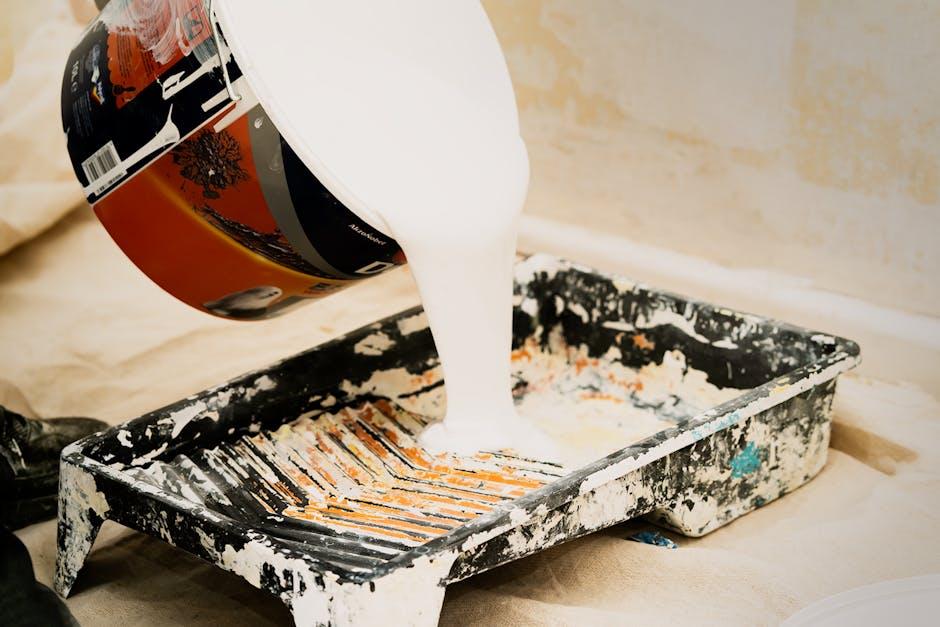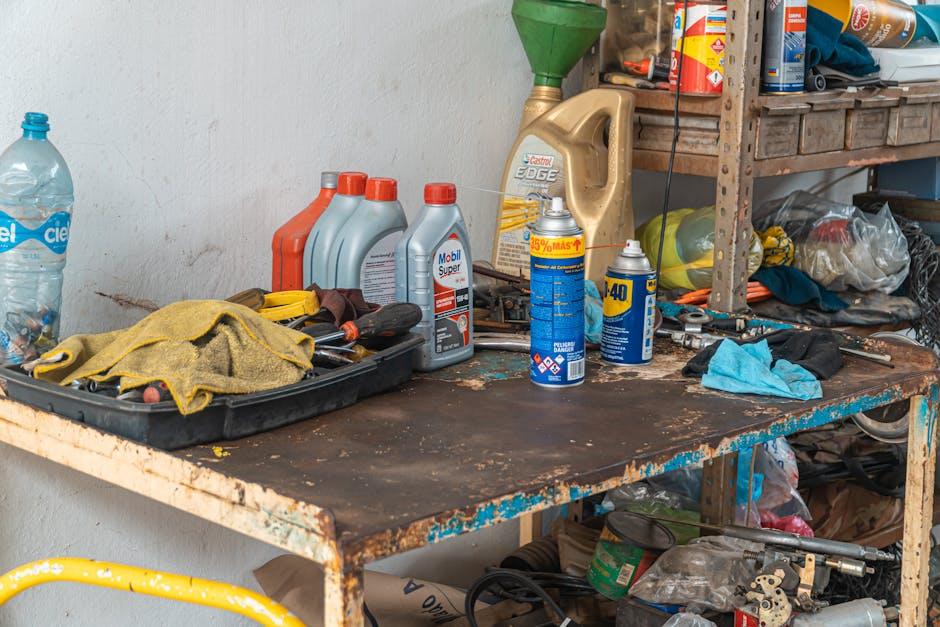Changing the oil in your car at home can be a satisfying and cost-effective way to keep your vehicle running smoothly. But before you roll up your sleeves, having the right tools at your side makes all the difference between a quick, clean job and a frustrating ordeal. From the essentials that every DIY mechanic swears by to handy extras that make the process cleaner and easier, this guide explores the best tools to equip your home oil change setup. Whether you’re a seasoned pro or a first-timer, these carefully selected tools will help you get under the hood with confidence.
Table of Contents
- Choosing the Right Oil for Your Vehicle’s Engine
- Essential Equipment for a Smooth Oil Change
- Top Rated Oil Drain Pans and Funnels for Home Use
- Best Oil Filter Wrenches That Make Removal Easy
- Must-Have Safety Gear to Protect Yourself During the Process
- Step by Step Guide to Using Your Tools Efficiently
- Q&A
- In Summary

Choosing the Right Oil for Your Vehicle’s Engine
Selecting the ideal engine oil depends largely on your vehicle’s make, model, and the environment in which you typically drive. Viscosity, denoted by numbers like 5W-30 or 10W-40, plays a crucial role in protecting your engine across various temperatures. A lower number before the “W” indicates better flow during cold starts, while the second number reflects how the oil performs at operating temperature. It’s always wise to consult your owner’s manual or a trusted mechanic to match the oil’s viscosity grade perfectly with your engine’s requirements.
Beyond viscosity, there are several oil types to consider. Your options include:
- Conventional oil: Standard and cost-effective but requires more frequent changes.
- Synthetic oil: Enhanced durability and performance, ideal for high-performance or older engines.
- Synthetic blend: A mix providing better protection than conventional but at a moderate price.
- High-mileage oil: Formulated with additives to protect and repair aging engines.
| Oil Type | Best For | Change Interval |
|---|---|---|
| Conventional | Daily drivers, budget-conscious | 3,000 – 5,000 miles |
| Synthetic | Performance vehicles, extreme climates | 7,500 – 10,000 miles |
| Synthetic Blend | Light towing, moderate use | 5,000 – 7,500 miles |
| High-Mileage | Engines >75,000 miles | 3,000 – 7,500 miles |

Essential Equipment for a Smooth Oil Change
To perform a seamless oil change at home, having the right tools at your fingertips is crucial. A quality oil drain pan with a wide mouth prevents spills, making cleanup effortless and protecting your workspace. Don’t forget a sturdy wrench set to safely remove the drain plug, and a funnel ensures precise oil pouring without mess. For added convenience, an oil filter wrench helps you remove stubborn filters without damaging them. Additionally, disposable gloves keep your hands clean and protected from harsh chemicals during the process.
Organizing your equipment can dramatically improve efficiency. Consider having these essentials within reach:
- Oil drain pan (capacity based on your vehicle’s requirements)
- Socket wrench or spanner set
- Oil filter wrench
- Funnel with a wide mouth
- Fresh replacement oil filter
- Durable gloves
- Rags or shop towels for quick cleanup
| Tool | Purpose | Tip |
|---|---|---|
| Oil Drain Pan | Collect old oil | Choose one with a spout for easy pouring |
| Funnel | Pour new oil accurately | Opt for a flexible funnel for tight engine spaces |
| Oil Filter Wrench | Remove tough filters | Use a strap wrench for non-slip grip |

Top Rated Oil Drain Pans and Funnels for Home Use
When performing an oil change at home, having the right tools can make the process smooth and mess-free. Oil drain pans come in a variety of sizes and designs, tailored to catch every drop without spills. A pan with raised edges and a wide spout ensures no accidental overflow, while those made from durable materials resist dents and stains over time. Many top-rated options feature built-in handles for easy carrying and pouring, as well as detachable lids to keep used oil contained during disposal.
Funnels may seem simple but choosing one with a large mouth and an extended neck can save you from frustrating spills, especially with used oil that tends to be thicker and messier. Look for funnels with built-in strainers to filter out debris, protecting your engine during refills. For best results, consider these essentials for your tool kit:
- Flexible funnels: Adapt to awkward angles and tight engine spaces.
- Wide-mouth pans: Capture oil quickly from high flow drains.
- Non-slip bases: Prevent accidental tipping on smooth surfaces.
| Brand | Capacity | Material | Special Features |
|---|---|---|---|
| OilMaster Pro | 5 Quarts | Reinforced Plastic | Built-in spout & handle |
| FlexiFunnel | – | Silicone | Flexible neck with filter |
| DrainSafe 360 | 7 Quarts | Steel | Lid & non-slip base |

Best Oil Filter Wrenches That Make Removal Easy
Removing an oil filter can often be a stubborn challenge during a DIY oil change, but the right tool will make the task smooth and hassle-free. Among the variety of options, strap wrenches stand out for their versatility and gentle grip, preventing damage to the filter casing. If you prefer precision, a cup-style wrench offers a snug fit that matches specific filter sizes, ensuring a firm hold for an easy twist off. For mechanics who value speed, claw-type wrenches combine a strong grip with quick adjustment capabilities, suited for tighter spaces.
Choosing the ideal wrench depends on your vehicle’s filter design and workspace constraints. Here’s a quick comparison to help you decide:
| Type | Best For | Key Feature | Ease of Use |
|---|---|---|---|
| Strap Wrench | Various Sizes | Non-damaging grip | High |
| Cup Wrench | Specific Filter Sizes | Perfect fit | Medium |
| Claw Wrench | Tight Spaces | Adjustable teeth | Medium-High |
For every home mechanic aiming to make oil changes less daunting, investing in these quality wrenches can save both time and frustration. Plus, they ensure your filters can be removed cleanly without causing leaks, making your maintenance process as smooth as possible.

Must-Have Safety Gear to Protect Yourself During the Process
When tackling an oil change at home, safeguarding yourself is just as crucial as having the right tools. Start with a sturdy pair of mechanic gloves to protect your hands from hot oil and sharp components. These gloves not only provide a barrier against grime and chemicals but also enhance your grip, helping you maneuver tools with confidence. Don’t forget a pair of safety goggles—these protect your eyes from unexpected oil splashes or debris, ensuring your vision remains clear throughout the job.
Additionally, wearing a long-sleeved shirt and pants made from durable fabric shields your skin from burns and stains. Complement your attire with a work apron for extra coverage and easy cleanup. To keep your workspace safe and efficient, consider using a quality oil drain pan equipped with a splash guard, reducing the risk of spills and slips. Together, these safety essentials create a protective barrier that lets you focus on changing your oil without worry.

Step by Step Guide to Using Your Tools Efficiently
Begin by organizing your workspace and laying out the tools you’ll need. This preparation will streamline the entire oil change process. Ensure you have a quality oil pan positioned directly under the drain plug to catch the old oil—avoiding messy spills. Next, use the correct size socket wrench to loosen the drain plug; applying steady, controlled force will prevent stripping. Once drained, replace the oil filter by unscrewing it with an oil filter wrench, but don’t forget to lubricate the new filter’s rubber gasket with fresh oil before installation. This simple step ensures a perfect seal and prevents leaks.
When it comes to filling fresh oil, a funnel is your best friend. Use it to pour without splashes, keeping your engine bay clean. Remember to check the oil level using the dipstick—add oil gradually and double-check the level to avoid overfilling. Here’s a quick reminder of the essential tools and their best uses:
| Tool | Purpose | Efficiency Tip |
|---|---|---|
| Oil Pan | Collect used oil | Position accurately to catch all oil |
| Socket Wrench | Remove drain plug | Use correct size for firm grip |
| Oil Filter Wrench | Remove/install oil filter | Lubricate gasket before installing new filter |
| Funnel | Pour fresh oil | Prevents spills for a clean refill |
Q&A
Q&A: Best Tools for a Home Oil Change
Q1: Why should I consider doing an oil change at home?
A1: Changing your vehicle’s oil at home can save money, give you hands-on understanding of your car’s maintenance, and allow you to control the quality of oil and filter you use. It’s a practical skill that adds to your automotive confidence.
Q2: What are the essential tools I need for a successful home oil change?
A2: At minimum, you’ll need a few key items: a sturdy jack and jack stands or ramps to safely lift the car, a wrench or socket set for removing the drain plug, an oil filter wrench to pull out the old filter, a drain pan to catch the used oil, and a funnel for adding new oil cleanly.
Q3: How do I choose the right oil filter wrench?
A3: Oil filters come in various sizes and shapes, so your wrench should fit snugly to avoid damaging the filter. Strap wrenches work well for odd sizes, while cap wrenches offer a secure fit. Some kits even include universal filter wrenches for versatility.
Q4: Is it necessary to use ramps instead of a jack and stands?
A4: Both have their advantages. Ramps provide a stable, gradual incline that’s easy to drive onto, making access accessible and quick. Jack and stands allow more clearance and flexibility but require careful use for safety. Choose based on your vehicle’s clearance and comfort level.
Q5: Can I reuse any of the tools or materials after the oil change?
A5: Many tools, like your wrench sets, funnels, and jacks, are reusable. However, the oil filter and the used oil should be replaced and recycled properly. A good oil catch pan can be emptied and cleaned for future use, reducing waste.
Q6: Are there any safety tools or gear recommended when doing a home oil change?
A6: Absolutely. Gloves protect your hands from hot oil and grime. Safety glasses shield your eyes from splashes. Additionally, having rags and absorbent mats nearby helps manage spills safely. Proper ventilation is also important if you’re working in a closed space.
Q7: Where should I dispose of the used oil and filter?
A7: Never pour used oil down drains or onto the ground. Most auto parts stores or recycling centers accept used oil and filters for proper disposal. Check local regulations to find the nearest environmentally friendly recycling option.
Q8: How do I know if my oil change tools are good quality?
A8: Durable materials like heavy-duty steel for wrenches, sturdy plastic or metal jacks, and leak-proof containers signal quality. Reading user reviews and opting for reputable brands also helps ensure your tools will last through many oil changes.
Q9: Can beginner car owners master a home oil change with these tools?
A9: Yes! With the right tools and a bit of patience, beginners can successfully change their own oil. Many online tutorials and vehicle manuals provide step-by-step guidance, making this an accessible task that builds valuable skills.
Q10: What’s the final tip for a smooth home oil change experience?
A10: Preparation is key – gather all your tools and supplies before starting, work on a flat surface, and double-check your car’s oil type and quantity requirements. Taking your time and being methodical ensures a clean, efficient, and safe oil change every time.
In Summary
Changing your own oil at home can be a rewarding blend of saving money, gaining mechanical confidence, and keeping your vehicle in top shape. With the right tools by your side—from quality wrenches and oil catch pans to trusted funnels and sturdy gloves—you’re not just performing a maintenance task; you’re mastering a skill. Equip yourself thoughtfully, follow best practices, and watch as your garage transforms into a personal pit stop. After all, the right tools don’t just make the job easier—they make every oil change a step toward automotive independence.

